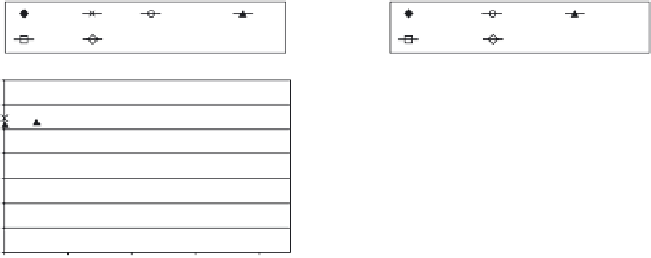Biomedical Engineering Reference
In-Depth Information
(a)
(b)
PVC
Eu
BG
Ti6Al4V
Be
PVC
Eu/BG
Ti/BG
Be/BG
Sa
Sa/BG
1.4
1.2
1.0
0.8
0.6
0.4
0.2
0.0
10
1.4
1.2
1.0
0.8
0.6
0.4
0.2
0.0
10
30
50
70
90
30
50
70
90
Extract concentration (%)
Extract concentration (%)
Figure 11.25.
Relative cellular activity from the solvent extraction test for (a) uncoated
bioSiC and (b) coated bioSiC with bioactive glass by PLD. PVC: positive toxic control; BG:
bioactive glass, Ti6Al4V: titanium alloy; Be, Eu, Sa: beech, eucalyptus and sapelli; Ti/BG: Ti
coated with bioactive glass; Be/BG, Eu/BG, Sa/BG: beech, eucalyptus and sapelli-based SiC
ceramics coated with bioactive glass. From [Borrajo, 2006].
a proliferation rate similar to that of the Thermanox control and reference mate-
rials. The hydroxyapatite and Si-substituted apatite coated SiC extracts also did
not affect cellular activity at any of the concentrations tested (not shown), their
values being similar to the ones obtained with the Thermanox cytotoxic negative
control. A slight decrease in cellular activity could be observed for the 100% con-
centration of the coated SiC ceramic extract, which was not over the signifi cant
limits.
There were no signifi cant differences when the cellular attachment response
of the cells to the wood-based biomorphic SiC ceramics, uncoated or coated with
bioactive materiales (hydroxyapatite, Si-substituted apatite and bioactive glass),
was compared to the one exhibited by reference materials Ti6Al4V and bulk
bioactive glass. These facts demonstrate that bioinspired ceramics coated with
bioactive materials do not have any negative effects on the activity of MG-63
osteoblast-like cells and this fact is very promising for biomedical applications.
11.5.2
In Vitro
Cell Attachment and Proliferation Tests
The ability of bioSiC to sustain cell attachment and growth was assessed by
seeding MG-63 human osteoblast-like cells on the material [de Carlos, 2006;
Borrajo, 2006]. The attachment of the cells on beech, eucalyptus and sapelli-based
biomorphic SiC ceramics coated with bioactive glass was compared by means of
SEM (Figure 11.26). Provided that the same number of cells (10
5
cells/cm
2
) has
been seeded, the attachment of the cells occurs in the same way in all tested
samples. None of the wood-based SiC ceramics, coated or uncoated, exhibited a
higher rate of cell attachment and growth. The cells attached in the same effi cient













Search WWH ::

Custom Search